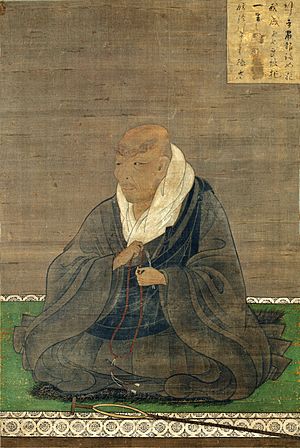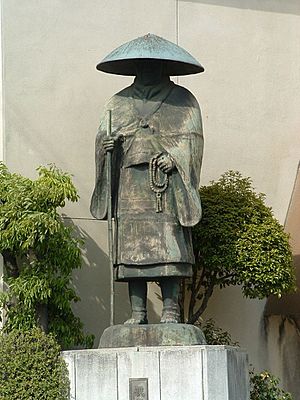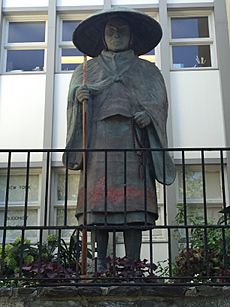Shinran facts for kids
Quick facts for kids Shinran (親鸞) |
|
|---|---|

Shinran (ICP) (Nara National Museum)
|
|
| Religion | Buddhism |
| School | Jōdo Shinshū Buddhism |
| Personal | |
| Born | Matsuwakamaro May 21, 1173 Heian-kyō, Yamashiro Province (now Kyoto, Japan) |
| Died | January 16, 1263 (aged 89) Heian-kyō, Yamashiro Province |
| Spouse | Eshinni |
| Children | Kakushinnhi, Zenran, others |
| Senior posting | |
| Title | Founder of Jōdo Shinshū Buddhism |
| Religious career | |
| Teacher | Hōnen |
Shinran (親鸞, May 21, 1173 – January 16, 1263) was a Japanese Buddhist monk. He was born in Hino, which is now part of Fushimi, Kyoto. This was during a time of big changes in Japan, at the end of the Heian Period and into the Kamakura Period. Shinran was a student of a famous monk named Hōnen. He also started his own important branch of Japanese Buddhism, called Jōdo Shinshū.
Contents
Shinran's Many Names
Shinran's birth name was Matsuwakamaro. In Japan, people often had different names throughout their lives. Shinran was also known as Hanen, Shakku, and Zenshin. His final name, Shinran, came from combining parts of two other Buddhist teachers' names: Seshin and Donran. After he passed away, he was given the special title Kenshin Daishi.
For a while, he also used the name Fujii Yoshizane. Later, after he was no longer a monk, he called himself Gutoku Shinran. This name meant "stubble-haired foolish one." He used it to show that he was "neither a monk nor a regular person."
Shinran's Life Story
Shinran was born on May 21, 1173. His parents were Lord and Lady Arinori, who belonged to the powerful Fujiwara clan. Sadly, both of Shinran's parents died when he was young. In 1181, when he was nine years old, he joined the Shōren-in temple near Kyoto. He wanted to understand what happens after death.
Some modern historians think he might have become a monk with his father. This was because of the difficult times during the Genpei War. When he entered the temple, he wrote a poem about how quickly life can change. He spent the next 20 years training at Mt. Hiei. Letters from his wife show he was a "hall monk" there.
Shinran felt frustrated because he couldn't reach enlightenment through traditional monk practices. He went to the Rokkaku-dō temple for a retreat. There, he had a special vision. A figure named Avalokitesvara, appearing as Prince Shōtoku, told him to find another monk named Hōnen.
In 1201, Shinran met Hōnen and became his student. Shinran was 29 years old. He believed he found salvation through Amida's Vow during his first year with Hōnen. Hōnen even shared a secret writing, the Senchakushū, with Shinran.
While studying with Hōnen, Shinran did something very unusual for a monk. He publicly got married and ate meat. Monks were not allowed to do these things. Shinran did this to show that Amida's salvation was for everyone, not just for monks.
In 1207, other Buddhist leaders in Kyoto convinced the government to ban the nembutsu practice. Hōnen and Shinran were sent away from Kyoto. Shinran was no longer a monk and was sent to Echigo Province (now Niigata Prefecture). They never saw each other again. Hōnen died in Kyoto in 1212.
Being sent away was a very important moment for Shinran. He was no longer a monk, so he called himself Gutoku (愚禿, "Foolish, bald-headed one"). This showed he felt he was neither a monk nor a regular person. During his exile, he lived among common people. He continued to teach about salvation through Amida Buddha's kindness, using the nembutsu practice. Over time, his teachings became different enough from Hōnen's that his followers called his path Jōdo Shinshū, meaning "True Essence of the Pure Land Sect."
Shinran married Eshinni and they had seven children together.
Five years later, in 1211, the ban on nembutsu was lifted. Shinran was allowed to return to Kyoto, but he chose not to. Instead, he moved to Inada in the Kantō area, north of Tokyo. In 1224, Shinran wrote his most important book, Kyogyoshinsho. This book explained his Pure Land Buddhist ideas.
Around 1234, Shinran returned to Kyoto with his daughter, Kakushinni. He found out that his oldest son, Zenran, who stayed in Kantō, was telling people he had special teachings from Shinran. Zenran was misleading people. Shinran wrote strong letters to Zenran, telling him to stop. When Zenran refused, Shinran disowned him. This meant he no longer considered Zenran his son.
Shinran died in Kyoto in 1263, when he was 90 years old. His daughter Kakushinni was very important in keeping his teachings alive. Her family later became the leaders of the Honganji Temples, which were built around Shinran's resting place.
Shinran's Timeline
- 1173: Shinran is born.
- 1175: Hōnen starts the Jōdo-shū sect.
- 1181: Shinran becomes a monk.
- 1201: Shinran becomes Hōnen's student and leaves Mt. Hiei.
- 1207: The nembutsu practice is banned, and Shinran is sent away.
- 1211: Shinran is allowed to return from exile.
- 1212: Hōnen passes away in Kyoto. Shinran moves to Kantō.
- 1224: Shinran writes his important book, Kyogyoshinsho.
- 1234: Shinran moves back to Kyoto.
- 1256: Shinran disowns his son Zenran.
- 1263: Shinran dies in Kyoto.
Shinran's Teachings
Shinran always saw himself as Hōnen's student, even after they were separated. His wife, Eshinni, wrote about his strong loyalty. She said Shinran would go anywhere with Hōnen, even if it meant a difficult rebirth.
Hōnen's students had different ideas about how many times to say Amitabha's name (the nembutsu). Some focused on saying it many times, others on just one time. Shinran believed that faith was more important than how much you practiced. However, he didn't support the idea of just one recitation.
Shinran's teachings were mostly like other Pure Land Buddhist ideas. But he also had some unique views.
The Importance of Faith
Shinran believed that in the Latter Day of the Dharma, it was no longer possible to reach enlightenment through old monastic practices. He felt people could only rely on the promises of Amitabha Buddha. This meant trusting in Amitabha's 18th or "Primal Vow" to be reborn in the Pure Land.
In his main book, the Kyōgyōshinshō, Shinran wrote that he gave up traditional practices. He focused only on being reborn in the Pure Land. Over time, he even stopped focusing on practices for Pure Land rebirth. He decided to rely completely on faith in Amitabha Buddha's promise.
In the Kyōgyōshinshō, Shinran explains that "true faith" comes from Amitabha Buddha, not from the person. When this faith awakens, saying the Buddha's name (nembutsu) becomes an expression of thanks. This happens when a person fully trusts Amitabha Buddha, even for a moment. Once this faith is given, the person is sure to be reborn in the Pure Land and eventually reach enlightenment.
Shinran warned that true faith always involves Amitabha's name. But saying Amitabha's name doesn't always mean you have true faith. This faith comes from Amitabha's powerful promise.
Once a follower has this deep faith, they should live their life with gratitude. They should act morally and fulfill their duties. As faith in Amida grows, Shinran said ten spiritual benefits appear. These include being protected by divine beings, having great virtue, turning bad things into good, and always practicing great compassion.
Amitabha Buddha and the Pure Land
The last parts of the Kyōgyōshinshō talk about Amitabha Buddha and the Pure Land. The Pure Land is seen as a temporary place where one can reach enlightenment. After that, one can return to this world to help others as a bodhisattva.
Shinran also said in another writing, the Tannishō (歎異抄, "Lamentation of Divergences"): 浄土の慈悲といふは、念仏して、いそぎ仏になりて、大慈大悲心をもて、おもふがごとく衆生を利益するをいふべきなり。 The compassion in the Path of Pure Land is to quickly attain Buddhahood, saying the nembutsu, and with the true heart of compassion and love save all beings completely as we desire.
Shinran believed that Amitabha Buddha and the Pure Land are beyond our full understanding. But because people have limited understanding, they see Amitabha in a physical form. If someone gains true faith, they will see Amitabha's true form upon rebirth in the Pure Land. If faith is not complete, they will be reborn in the outer parts of the Pure Land. There, they will still see Amitabha in physical forms until they gain true faith.
Shinran's idea of Amitabha Buddha as the ultimate reality, and the Pure Land as Nirvana itself, was a bit different from older Buddhist teachings.
The Age of Dharma Decline
Shinran believed in the idea of the final age of the Dharma. This was a common idea among Buddhist thinkers at the time. He was inspired by a Chinese Buddhist master named Tao-cho. Tao-cho taught that in this later age, Pure Land teachings were best for people.
Shinran felt that this decline was unavoidable. He thought Japan was already 600 years into this age. He believed people could no longer keep up with traditional Buddhist practices or reach enlightenment on their own. So, only Amitabha Buddha's promise to save everyone could be relied upon.
Other Religious Practices
Shinran knew about other religious practices in Japan, like Shinto kami (spirits), divination, and astrology. However, he believed they were not important compared to Amitabha Buddha's power. He taught that other religious practices were like worshipping demons. His followers later used this idea to make sure people understood Shinran's teachings correctly. They also used it to criticize other Buddhist groups. Even today, you won't find good luck charms like omamori or ofuda in Jodo Shinshu temples.
Shinran's Lasting Impact
There is a statue of Shinran Shonin in Upper West Side Manhattan, New York City. It stands on Riverside Drive between 105th and 106th Streets, in front of the New York Buddhist Church. The statue shows Shinran wearing a peasant hat and sandals, holding a wooden staff.
This type of statue is common at Jōdo Shinshū temples. But this one is special because it survived the atomic bombing of Hiroshima. It was only about a mile from where the bomb hit. The statue was brought to New York in 1955. A plaque on it calls the statue "a testimonial to the atomic bomb devastation and a symbol of lasting hope for world peace."
Shinran's life was also made into a movie in 1987 called Shinran: Path to Purity. The film won an award at the 1987 Cannes Film Festival.
On March 14, 2008, some of Shinran's ashes were found. They were inside a small wooden statue at the Jōrakuji temple in Shimogyō-ku, Kyōto. The temple was built by Zonkaku, who was Shinran's great-great-grandson. Records show that Zonkaku received Shinran's remains from his father. The wooden statue is from the middle of the Edo period, and the remains were wrapped in paper.
In March 2011, a manga artist named Takehiko Inoue created large ink paintings. They were displayed at the East Hongan Temple in Kyoto. The paintings showed Shinran and Hōnen with people from the Heian period. Another set showed Shinran sitting with a bird.
See also
 In Spanish: Shinran para niños
In Spanish: Shinran para niños
- Faith in Buddhism
- Jōdo Shinshū
- Statue of Shinran, Tokyo




